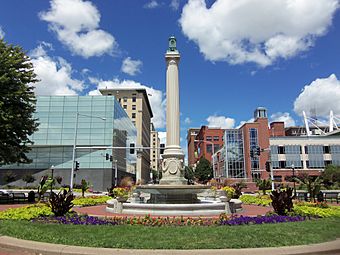Dillon Memorial facts for kids
|
Dillon Memorial
|
|
 |
|
| Location | S. Main St. Davenport, Iowa |
|---|---|
| Area | less than one acre |
| Built | 1918-1919 |
| Architect | Franklin & Arthur Ware, Paul Schultz |
| Architectural style | Classical Revival |
| MPS | Davenport MRA |
| NRHP reference No. | 83002421 |
Quick facts for kids Significant dates |
|
| Added to NRHP | July 7, 1983 |
The Dillon Memorial is a special monument in LeClaire Park. It is located near downtown Davenport, Iowa. Many people call it the Dillon Fountain. It was added to the National Register of Historic Places in 1983. This means it is an important historical site in the United States. It was also listed on the Davenport Register of Historic Properties in 1993.
History of the Dillon Memorial
The Dillon Memorial honors John Forrest Dillon. He was a lawyer from Davenport. He also served as a judge on the Iowa Supreme Court. Later, he became a judge for the United States Circuit Court. After he passed away in 1914, his will asked for this fountain to be built. He also said where it should be located.
The memorial is at the south end of Main Street. It faces the Civil War Monument. That monument is twelve blocks north on top of a bluff. The Dillon Memorial was also meant to be a main point for Main Street. This street connects LeClaire Park to Vander Veer Botanical Park in central Davenport.
When the memorial was built from 1918 to 1919, there were no other buildings on the south side of River Drive. The memorial was part of a big plan to improve the riverfront. This plan was led by the Levee Improvement Commission. Other projects included Union Station and the W.D. Petersen Memorial Music Pavilion. At this time, Riverfront Park was renamed LeClaire Park.
In 1922, a public swimming pool was built near the memorial. A year later, the Lend-A-Hand Club building was constructed nearby. The Lend-a-Hand building is also a historic site. Later, the swimming pool and Lend-a-Hand buildings were taken down. This brought the memorial area back to its original look. In 1997, Main Street was closed south of River Drive. This area then became part of LeClaire Park. A brick plaza was built around the fountain at that time.
Design and Architecture
The Davenport Levee Improvement Commission held a contest to design the memorial. Franklin and Arthur Ware, artists from New York City, won the contest. They designed the memorial with Paul Schultz.
The Dillon Memorial is built in a style called Neoclassical. This style uses ideas from ancient Greek and Roman buildings. It was a popular style for monuments and public buildings back then. Arthur Ware had studied this style in Paris.
The monument has a tall, grooved column. It stands in the middle of a round pool, which works as a fountain. A lantern sits on top of the column. The base of the column has special carvings called bas-reliefs. These carvings show lion heads and decorative garlands. There is also a bas-relief carving of Judge Dillon himself on the column.




